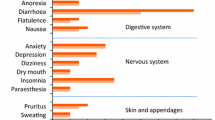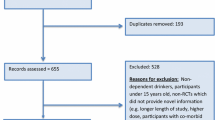Abstract
Rationale
Acamprosate is a proven effective intervention in the treatment of alcohol dependence. However, acamprosate prevents lapses or relapses only in a minority of patients. An important question, therefore, is whether there is a specific subgroup of patients who respond particularly well to acamprosate.
Objectives
To identify predictors of acamprosate efficacy. Based upon the available evidence and hypotheses about the mechanisms underlying acamprosate’s effects on drinking behavior, the following variables were considered to be potential positive predictors: high physiological dependence at baseline, negative family history of alcoholism, late age-of-onset, serious anxiety symptomatology at baseline, severe craving at baseline, and female gender.
Method
Potential predictors of acamprosate’s efficacy were analyzed in a pooled analysis of data from seven randomized placebo-controlled trials involving a total of 1485 patients with alcohol dependence. Outcome is measured in terms of cumulative abstinence duration (CAD), continuous abstinence (ABST), and time to first relapse (TFR).
Results
CAD and ABST were predicted by baseline measures of craving and anxiety, as well as by study and treatment condition. Acamprosate efficacy was not differentially associated with any of the predictor variables. Importantly, the hypotheses were rejected despite the large sample size and sufficient statistical power.
Comment
The most straight-forward clinical implication of this study is that acamprosate can be considered as a potentially effective pharmacotherapy for all patients with alcohol dependence. The effect size of acamprosate alone is, however, moderate. Some evidence indicates that the combination of acamprosate with naltrexone or disulfiram leads to substantially better outcomes.
Similar content being viewed by others
References
Ait-Daoud N, Johnson BA, Prihoda TJ et al. (2001) Combining ondansetron and naltrexone reduces craving among biologically predisposed alcoholics: preliminary clinical evidence. Psychopharmacology 154:23–27
Anderson TW (1957) Maximum likelihood estimates for a multivariate normal distribution when some observations are missing. J Am Statist Assoc 52:200–203
Besson J, Aeby F, Kasas A et al. (1998) Combined efficacy of acamprosate and disulfiram in the treatment of alcoholism: a controlled study. Alcohol Clin Exp Res 22:573–579
Chick J, Howlett H, Morgan MY et al. (2000) United Kingdom Multicenter Acamprosate Study (UKMAS): a 6-month prospective study of acamprosate versus placebo in preventing relapse after withdrawal from alcohol. Alcohol Alcohol 35:176–188
Choi CC (1998) Sample size in clinical trials with dichotomous endpoints, use of covariables. J Biopharm Stat 8:367–375
Cloninger CR (1987) Neurogenetic adaptive mechanisms in alcoholism. Science 236:410–416
Fleiss J (1985) Design and analysis of clinical experiments. Wiley, New York, pp 100–101
Geerlings PJ, Ansoms C, van den Brink W (1997) Acamprosate and prevention of relapse in alcoholics. Eur Addict Res 3:129–137
Gerra G, Caccavari R, Delsignore R et al. (1992) Effects of fluoxetine and Ca-acetyl-homotaurinate on alcohol intake in familial and nonfamilial alcoholic patients. Curr Ther Res 52:291–295
Gerra G, Ferri M, Zaimovic A et al. (1998) GABAergic function in detoxified heroin addicts: relationship to anxiety disorders. Psychiatry Res 77:89–96
Gual A, Lehert Ph (2001) Acamprosate during and after acute alcohol withdrawal: a double blind placebo controlled study in Spain. Alcohol Alcohol 36:413–418
Johnson BA, Roache JD, Javors MA et al. (2000) Ondansetron for reduction of drinking among biologically predisposed alcoholic patients: a randomized controlled trial. JAMA 284:963–971
Kiefer F, Jahn H, Tarnaske T et al. (2003) Comparing and combining naltrexone and acamprosate in relapse prevention of alcoholism: a double-blind, placebo-controlled study. Arch Gen Psychiatry 60:92–99
Koele P (1982) Calculating power in analysis of variance. Psychol Bull 92:513–516
Kranzler HR, Van Kirk J (2001) Efficacy of naltrexone and acamprosate for alcoholism treatment: a meta-analysis. Alcohol Clin Exp Res 25:1335–1341
Ladewig D, Knecht T, Lehert P et al. (1993) Acamprosate: a stabilizing factor in long-term withdrawal of alcoholic patients. Ther Umsch 50:182–188
Lehert Ph (1994) Guidelines on evaluation of treatment of alcohol dependence. Alcoholism 59:67
Lesch OM, Walter H (1996) Subtypes of alcoholism and their role in therapy. Alcohol Alcohol 31(Suppl):63–67
Little RJA, Rubin DB (1987) Statistical analysis with missing data. Wiley, New York
Littleton J (1995) Acamprosate in alcohol dependence: how does it work? Addiction 90:1179–1188
Littleton J, al Qatari M, Little H (1996) The neurobiology of craving: potential mechanisms for acamprosate. In: Soyka M (ed) Acamprosate in relapse prevention of alcoholism. Springer, Berlin Heidelberg New York, pp 27–46
Mason BJ (2001) Treatment of alcohol-dependent outpatients with acamprosate: a clinical review. J Clin Psychiatry 62(Suppl 20):42–48
Monterosso JR, Flannery BA, Pettinati H et al. (2001) Predicting treatment response to naltrexone: the influence of craving and family history. Am J Addict 10:258–268
Oslin DW, Berrettini W, Kranzler HR et al. (2003) A functional polymorphism of the μ-opioid receptor gene is associated with naltrexone response in alcohol-dependent patients. Neuropsychopharmacology 28:1546–1552
Pelc I, Verbanck P, Le Bon O et al. (1997) Efficacy and safety of acamprosate in the treatment of detoxified alcohol-dependent patients. A 90-day placebo-controlled dose-finding study. Br J Psychiatry 171:73–77
Poldrugo F (1997) Acamprosate treatment in a long-term community-based alcohol rehabilitation programme. Addiction 92:1537–1546
Samson HH, Harris RA (1992) The neurobiology of alcohol abuse. Trends Pharmacol Sci 13:206–211
Sass H (1995) Results from a pooled analysis of 11 European trials comparing acamprosate and placebo in the treatment of alcohol dependence [abstract]. Alcohol Alcohol 30:551
Sass H, Soyka M, Mann K et al. (1996) Relapse prevention by acamprosate: results from a placebo-controlled study on alcohol dependence. Arch Gen Psychiatry 53:673–680
Schuckit MA (1996) Recent developments in the pharmacotherapy of alcohol dependence. J Consult Clin Psychol 64:669–676
Spanagel R, Zieglgänsberger W (1997) Anti-craving compounds for ethanol: new pharmacological tools to study addictive processes. Trends Pharmacol Sci 18:54–59
Tempesta E, Janiri L, Bignamini A et al. (2000) Acamprosate and relapse prevention in the treatment of alcohol dependence. A placebo-controlled study. Alcohol Alcohol 35:202–209
Tsai GE, Ragan P, Chang R et al. (1998) Increased glutamatergic neurotransmission and oxidative stress after alcohol withdrawal. Am J Psychiatry 155:726–732
Van den Brink W (2003) The role of psychosocial interventions in the pharmacological treatment of alcohol dependence. Drugs Ther Perspect 2:16–21
Verheul R, van den Brink W, Geerlings PJ (1999) A three-pathway psychobiological model of craving for alcohol. Alcohol Alcohol 34:197–222
Whitworth AB, Fischer F, Lesch OM et al. (1996) Comparison of acamprosate and placebo in long-term treatment of alcohol dependence. Lancet 347:1438–1442
Wilde MI, Wagstaff AJ (1997) Acamprosate: a review of its pharmacology and clinical potential in the management of alcohol dependence after detoxification. Drugs 53:1038–1053
Winer BJ (1989) Statistical principles in experimental design, 3rd edn. McGraw Hill, New York
Acknowledgements
Merck-Lipha, France, provided data and statistical support, and covered the costs for meetings between the researchers. The clinical trials included in this meta-analysis comply with the current laws in the respective countries in which they were conducted.
Author information
Authors and Affiliations
Corresponding author
Rights and permissions
About this article
Cite this article
Verheul, R., Lehert, P., Geerlings, P.J. et al. Predictors of acamprosate efficacy: results from a pooled analysis of seven European trials including 1485 alcohol-dependent patients. Psychopharmacology 178, 167–173 (2005). https://doi.org/10.1007/s00213-004-1991-7
Received:
Accepted:
Published:
Issue Date:
DOI: https://doi.org/10.1007/s00213-004-1991-7




